Overview
The article titled “9 Key Qualities of an Effective Board Chairperson” provides a thorough examination of the essential traits and skills that significantly enhance the effectiveness of a board chairperson. This exploration likely includes critical qualities such as:
- Communication skills
- Strategic thinking
- Adaptability
- Integrity
These attributes collectively contribute to improved governance and leadership within an organization. Understanding these qualities is vital for union leadership, as they not only foster effective decision-making but also inspire confidence among board members and stakeholders alike. By recognizing and cultivating these traits, organizations can ensure that their leadership is both effective and responsive to the challenges they face.
Introduction
The effectiveness of a board chairperson significantly influences an organization’s trajectory, embodying qualities that foster collaboration, strategic thinking, and ethical leadership. As the linchpin of governance, the chairperson not only guides discussions but also cultivates an environment where diverse perspectives thrive, enhancing decision-making and organizational resilience. However, what essential traits distinguish an exceptional board chairperson from the rest? This article delves into nine key qualities that empower leaders to navigate complexities and inspire their teams, ultimately shaping the future of their organizations.
Votem: Secure and Compliant Online Voting Solutions
Votem’s CastIron platform delivers secure and compliant online voting solutions, expertly designed for entities with stringent governance requirements. By adhering to essential regulations such as NCUA, DOL, and ERISA, Votem not only bolsters voter trust but also catalyzes increased participation in the electoral process. With a proven track record of managing over 13 million votes, the platform showcases its efficiency and reliability in handling substantial volumes of ballots.
Its innovative mobile-first design stands as a game-changer, capable of amplifying voter turnout by up to three times on launch day, thus providing a significant advantage for organizations. Furthermore, features like the real-time quorum meter streamline the voting process, making it an indispensable tool for the board chairperson who is overseeing elections. With a steadfast commitment to , Votem establishes itself as a leader in the online voting landscape, empowering organizations to conduct elections with unwavering confidence and integrity.
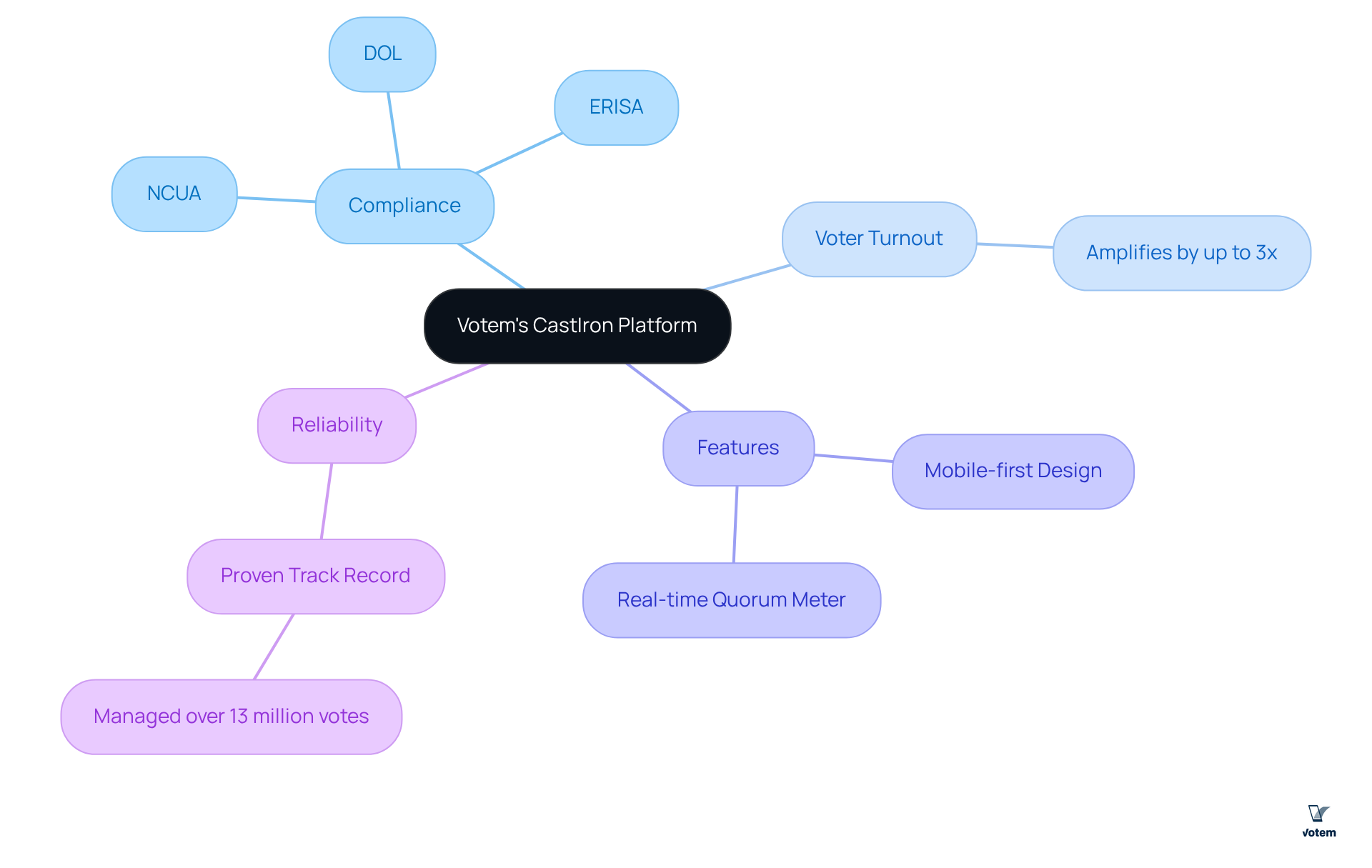
Strong Communication Skills: Essential for Leading Board Discussions
A board chairperson must possess strong communication skills to express ideas clearly and facilitate productive discussions. This encompasses not only speaking but also , ensuring that all members feel valued and understood. Effective communication is crucial for navigating complex issues and fostering a collaborative environment. Research indicates that 49% of employees plan to depart from their positions, underscoring the significance of efficient communication in retaining members and promoting engagement. Organizations prioritizing clear communication strategies report enhanced governance dynamics and reduced conflicts.
Prominent board chairpersons, recognized for their strong communication skills, have effectively managed intricate issues by fostering open dialogue and diverse viewpoints. Effective communication strategies for the governing body, such as providing easy-to-understand materials before meetings and sharing directors’ contact details, can greatly enhance collaboration. Furthermore, utilizing digital communication tools is essential for contemporary governance practices. Recent studies highlight that groups with effective communication practices are better prepared to tackle challenges and promote organizational success.
By cultivating a setting where every opinion is acknowledged, a leader can significantly improve the group’s overall efficiency and unity. How can we ensure that all voices are heard? By implementing these strategies, we can not only retain talent but also foster a more engaged and productive environment.

Collaborative Leadership: Fostering Teamwork Among Board Members
An effective board chairperson plays a crucial role in fostering collaborative leadership by promoting teamwork among committee members. This involves creating an inclusive environment where every voice is acknowledged and appreciated, which is essential for leveraging the diverse knowledge within the group. Notably, studies indicate that entities with a significant number of female members—specifically, those with 30% or more—experience enhanced internal cultural performance. This underscores the importance of in decision-making. By promoting open dialogue and teamwork, the board chairperson can facilitate more informed and effective decisions, ultimately enhancing the group’s overall impact.
Successful examples of teamwork among directors can be observed in initiatives such as the partnership between NeighborWorks America and BoardSource. This collaboration has significantly improved governance in community development entities by providing comprehensive training and resources. However, it is vital to recognize the potential drawbacks of token representation in leadership groups. Having only one woman or minority member can result in discomfort and diminished participation in discussions. The advantages of teamwork extend beyond individual contributions, leading to improved organizational performance and a stronger commitment to shared goals.
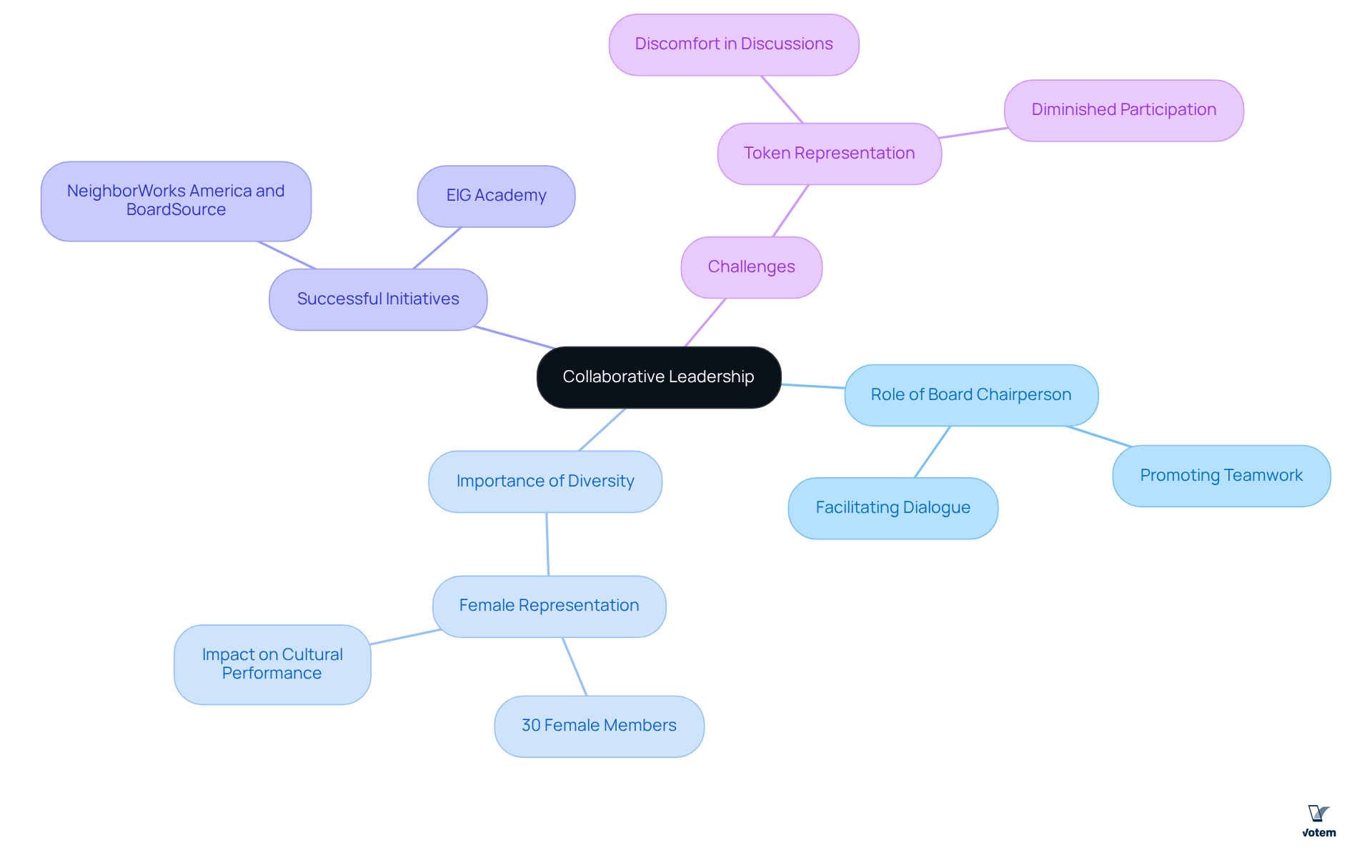
Strategic Thinking: Guiding the Organization Towards Its Goals
Strategic thinking is an indispensable quality for any governing leader, as it involves establishing a for the organization. This process encompasses:
- Identifying key priorities
- Assessing potential risks
- Aligning resources effectively to achieve long-term objectives
A strategic leader not only guides the team in making decisions that resonate with the organization’s mission and vision but also fosters a culture of proactive planning and adaptability. By embracing strategic thinking, leaders can navigate challenges with confidence and drive their entities toward success.
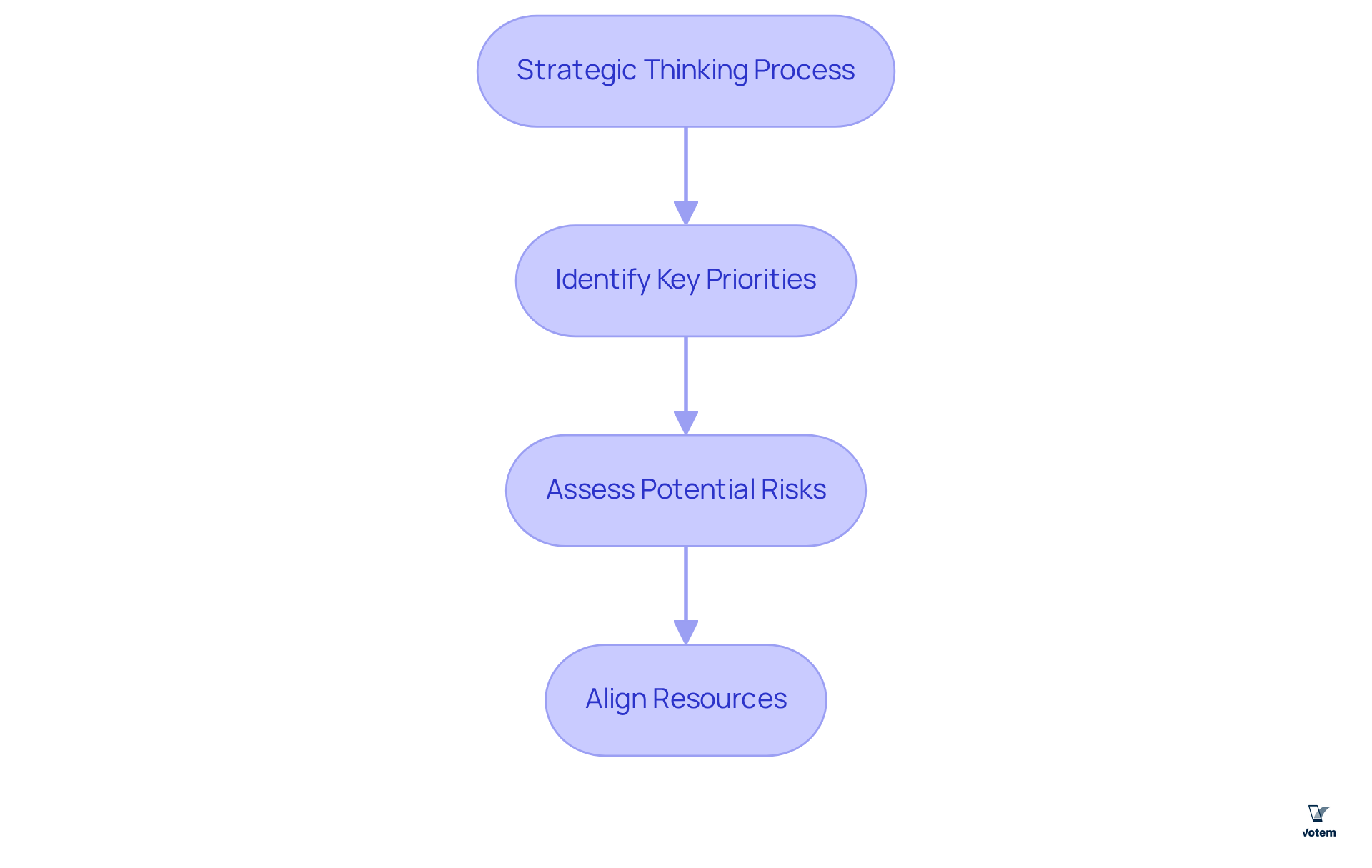
Integrity and Ethical Standards: Building Trust in Leadership
Integrity and ethical standards are imperative for effective leadership, serving as the foundation for trust within any organization. By consistently demonstrating honesty and transparency in all interactions, the chairperson cultivates robust relationships with members and stakeholders. This unwavering commitment to not only enhances the board’s credibility but also sets a commendable example for the entire organization. Research indicates that organizations led by ethical leaders witness a significant increase in employee satisfaction and engagement, reinforcing the notion that ethical governance is vital for building lasting trust.
Furthermore, board chairpersons who prioritize ethical practices are more likely to inspire their teams, creating an environment where open communication and accountability flourish. This proactive approach not only mitigates governance-related risks but also bolsters the organization’s reputation, ultimately driving improved performance and fostering stakeholder loyalty. For instance, Votem’s CastIron platform illustrates how ethical practices, such as security and transparency in elections, can significantly enhance trust and engagement within the community. Additionally, features like the real-time quorum meter streamline processes, showcasing the practical application of ethical standards in governance.
Conversely, the absence of ethical standards can result in diminished trust and financial decline, underscoring the critical importance of integrity in leadership, particularly within union governance. As such, union leaders must recognize the profound impact of their ethical decisions and strive to uphold the highest standards of integrity, thereby ensuring the sustainability and success of their organizations, which is often influenced by the board chairperson.
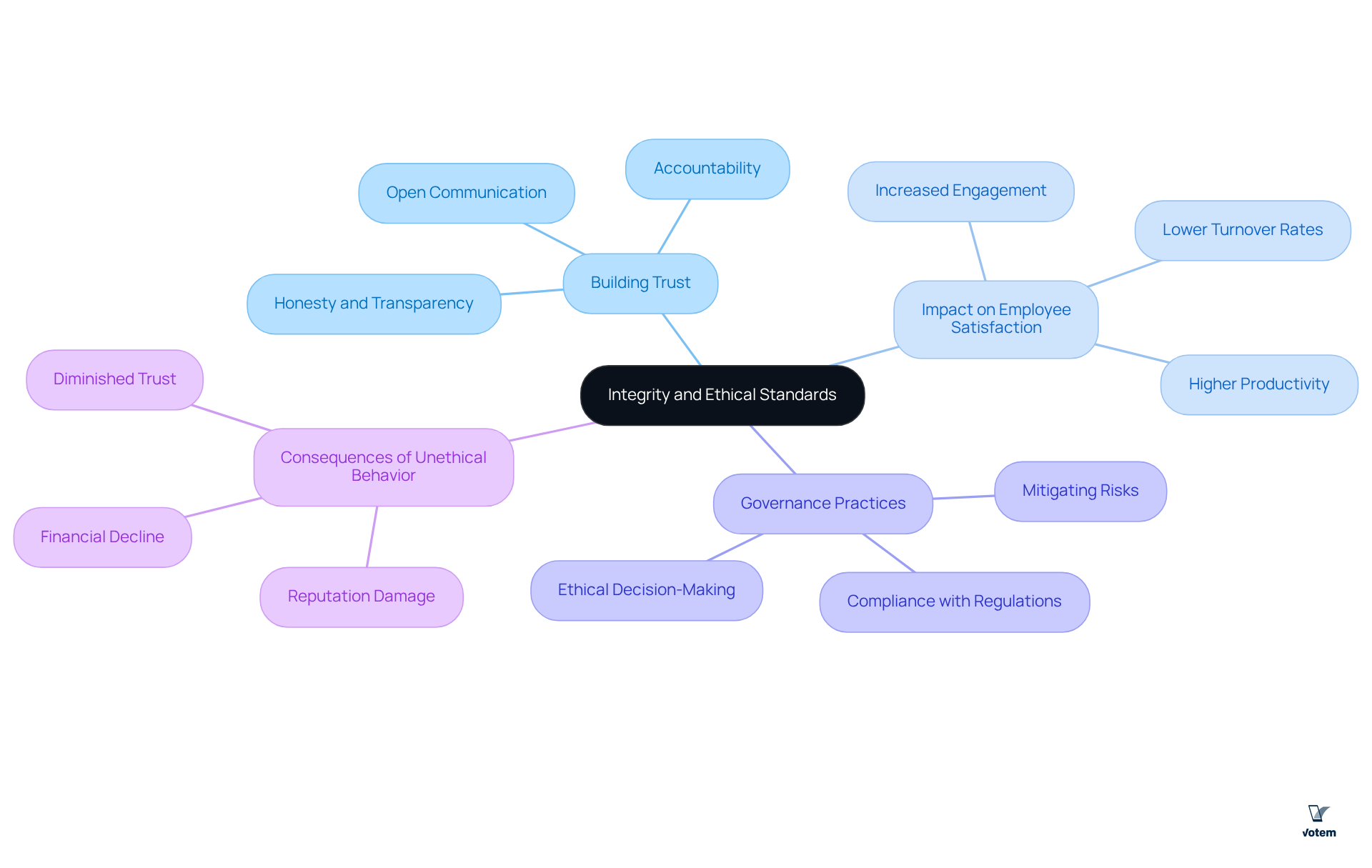
Adaptability: Navigating Change and Challenges Effectively
An effective leader embodies adaptability, a crucial trait for managing change and unexpected challenges. This adaptability involves openness to new concepts, necessary adjustments to strategies, and guiding the team through transitions. By nurturing a culture of resilience, board chairpersons ensure that their organizations can not only survive but also flourish in a rapidly evolving environment. The ability to pivot in response to external pressures, such as geopolitical disruptions or market volatility, is essential. For instance, firms with stronger cash positions during the COVID-19 crisis were better equipped to weather disruption, underscoring the importance of adaptability in maintaining organizational resilience.
Furthermore, continuous training and development for committee members enhance their capacity to tackle complexities, thereby strengthening the group’s effectiveness in steering the organization toward sustained success. As the saying goes, ‘Learning is leadership,’ which emphasizes the necessity of continuous learning in effective governance. In addition, committees must collaborate closely with management and the board chairperson to evaluate current standings and establish future objectives, ensuring strategic foresight.
Embracing diversity within corporate leadership is increasingly recognized as vital, as it provides diverse viewpoints that enhance decision-making and governance. This multifaceted approach not only enriches discussions but also , ultimately leading to more robust organizational strategies.
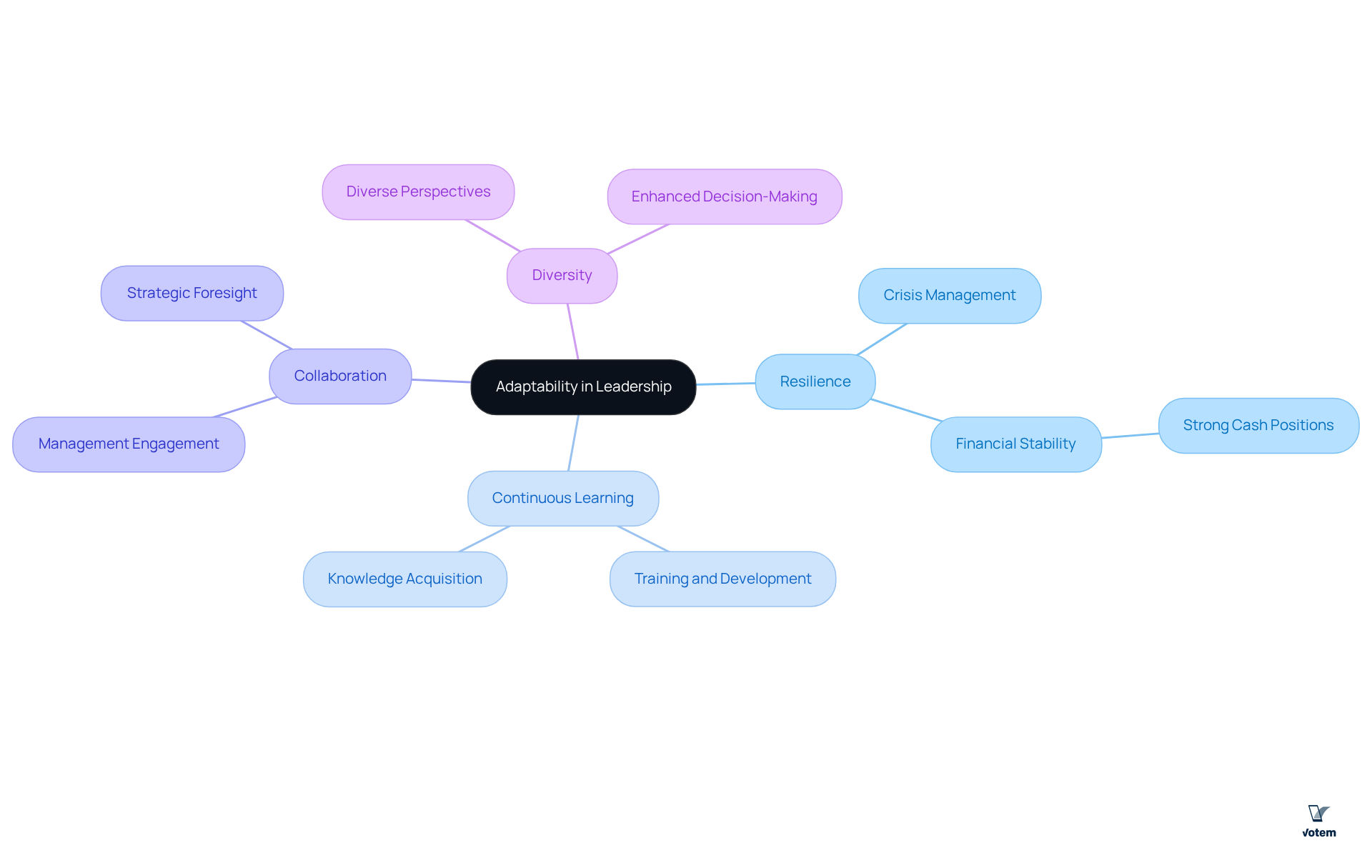
Conflict Resolution Skills: Managing Disagreements Effectively
Conflict resolution abilities are essential for leaders aiming to manage disagreements effectively. This necessitates the early identification of , fostering an atmosphere conducive to open discussions, and steering team members toward mutually beneficial solutions. A board chairperson adept in conflict management not only sustains a positive group dynamic but also enhances overall productivity during discussions.
Research from the Harvard Business Review indicates that constructive disagreement can significantly improve decision-making; groups that embrace diverse viewpoints often outperform those that avoid conflict. For example, establishing a clear code of conduct can delineate roles and responsibilities, thereby preventing misunderstandings that could escalate into larger issues.
Furthermore, groups that encourage respectful disagreement cultivate an environment where participants feel valued, leading to more effective solutions. Effective governance recognizes that proactively addressing disagreements is vital; silence breeds resentment, while open communication fosters trust and cooperation among members.
As Olivia Cloer, CEO of Charitable Allies, emphasizes, ‘The essential approach to handling conflicts among directors is to be proactive when the initial signs of disagreement arise, instead of allowing it to escalate into a larger issue.’
Moreover, it is crucial to acknowledge that while task conflict can enhance decision-making, relationship conflict can impede group performance if not addressed promptly.

Stakeholder Engagement: Ensuring All Voices Are Heard
An effective committee leader prioritizes stakeholder involvement by actively ensuring that all voices are heard in the decision-making process. This approach not only seeks input from diverse groups but also values their perspectives when making decisions. For instance, during a recent Strategic Planning Workshop, over 55 stakeholders—including students, parents, and community leaders—contributed to discussions that shaped the district’s future goals. This collaborative method enhances the organization’s legitimacy and fosters a culture of respect and inclusivity. As D45 Board of Education President Judy Degnan noted, “Their presence reminded us that our decisions will directly impact their future,” highlighting the significance of diverse perspectives.
To ensure that diverse voices are consistently heard, leaders can implement , such as surveys or dedicated discussion sessions, that invite contributions from all stakeholders. By doing so, they reinforce accountability and strengthen the organization’s connection to the community it serves. Furthermore, leveraging technology, such as mobile-first platforms that can boost participation, can enhance accessibility in stakeholder engagement. Notably, Votem has managed over 13 million votes, demonstrating the impact of effective engagement. This not only showcases the potential for increased involvement but also emphasizes the necessity of adapting to modern tools to engage stakeholders effectively.

Financial Acumen: Overseeing Budgets and Financial Decisions
Monetary expertise is a critical trait for a committee leader, encompassing the supervision of budgets and the development of informed economic choices. This expertise requires a comprehensive understanding of monetary statements, risk evaluation, and the assurance of the entity’s economic sustainability. A chairperson equipped with strong monetary skills can adeptly navigate the committee through complex economic landscapes, ultimately enhancing the entity’s resilience and strategic direction.
Effective fiscal oversight directly influences organizational sustainability. Entities that prioritize fiscal understanding at the governance level are better positioned to tackle economic challenges and seize growth opportunities. A notable example is the Masonic Homes Kentucky, where the newly appointed board chairperson, Keith Dreier, is expected to leverage his extensive experience to enhance fiscal governance and drive the organization’s success.
To manage budgets and monetary decisions effectively, chairpersons should adopt a . This includes:
- Regular assessments of monetary reports
- Active participation in strategic fiscal planning
- Fostering open communication with executives
By doing so, they ensure that the board remains informed and capable of making prudent economic decisions that align with the organization’s mission.
Expert opinions underscore the importance of fiscal oversight in governance. Leaders in the nonprofit sector assert that a chairperson’s monetary knowledge not only facilitates budget management but also instills confidence among stakeholders, fostering trust and transparency. The impact of diligent monetary oversight extends beyond immediate fiscal health; it establishes the foundation for long-term organizational sustainability and success.
Additionally, organizations like Votem, which comply with NCUA, DOL, ERISA, and SOC 2 standards, exemplify how compliance can enhance oversight of funds. Margaret Anadu’s commitment to social impact through monetary initiatives further highlights the significance of economic expertise in governance. Moreover, leveraging technology, such as Votem’s mobile-first UX that can increase turnout by up to 3× on launch day, can lead to heightened engagement and success in organizational initiatives. Chairpersons should also explore actionable strategies to enhance their financial oversight skills, including:
- Attending financial training workshops
- Collaborating with financial experts to deepen their understanding of fiscal management
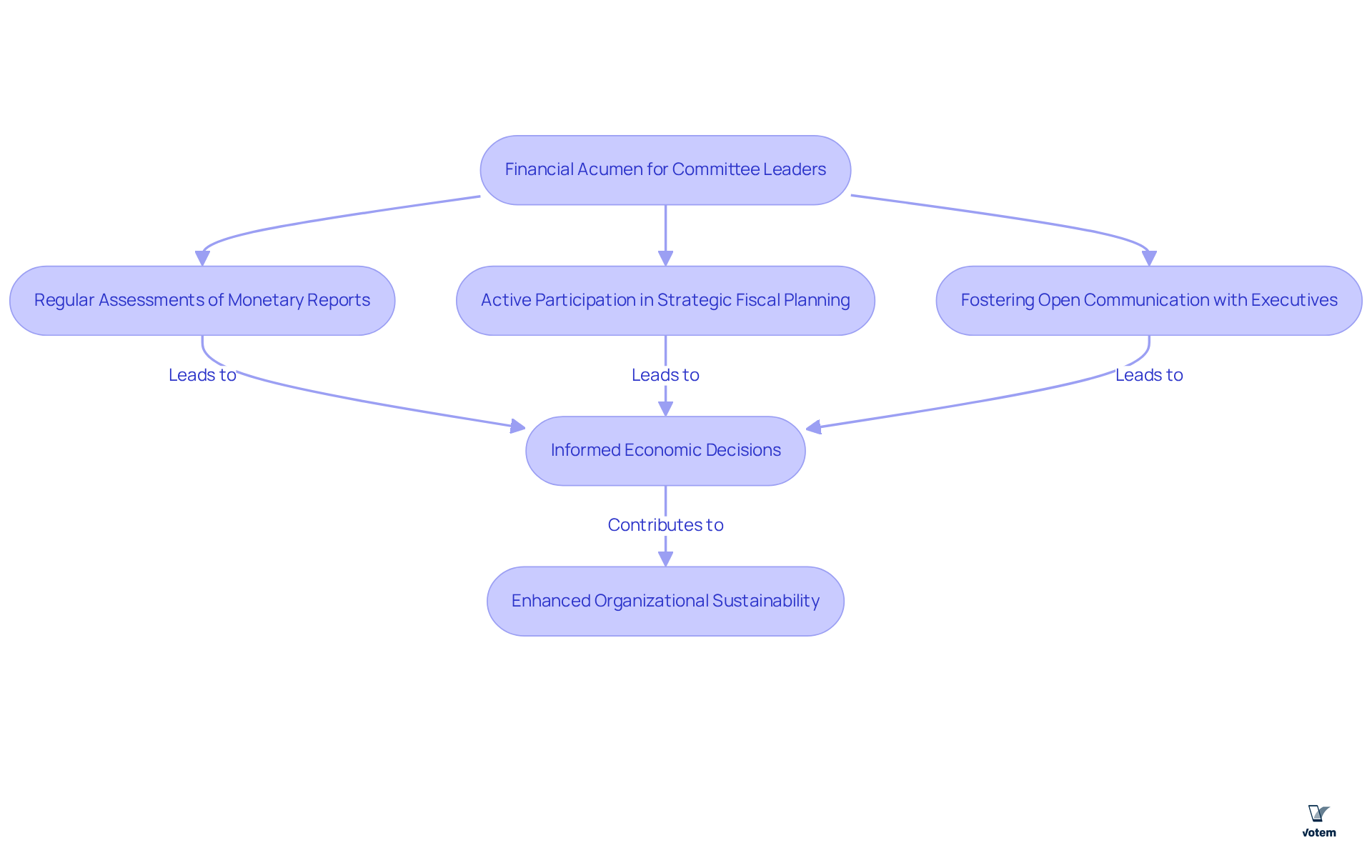
Vision and Foresight: Setting Long-Term Goals and Inspiring the Board
An effective committee leader embodies vision and foresight—qualities crucial for establishing long-term goals that drive organizational growth. By articulating a clear and compelling vision, the leader inspires members and cultivates a collaborative atmosphere where innovation can flourish. This leadership approach motivates the group to , ultimately driving progress and enhancing overall performance.
Successful leaders often set ambitious yet attainable goals, demonstrating how strategic foresight can lead to significant advancements. Expert opinions underscore that the board chairperson’s ability to inspire and engage the board is vital for cultivating a culture of accountability and shared purpose. This is essential for navigating the complexities of today’s dynamic organizational landscape.
Insights from studies on strategic foresight and business model innovation reveal that organizations with strong leadership are better positioned to adapt and thrive. A prime example is Votem, which successfully managed over 13 million votes, showcasing the tangible benefits of effective leadership. The evidence is clear: strong leadership not only fosters a thriving organizational culture but also drives measurable success.
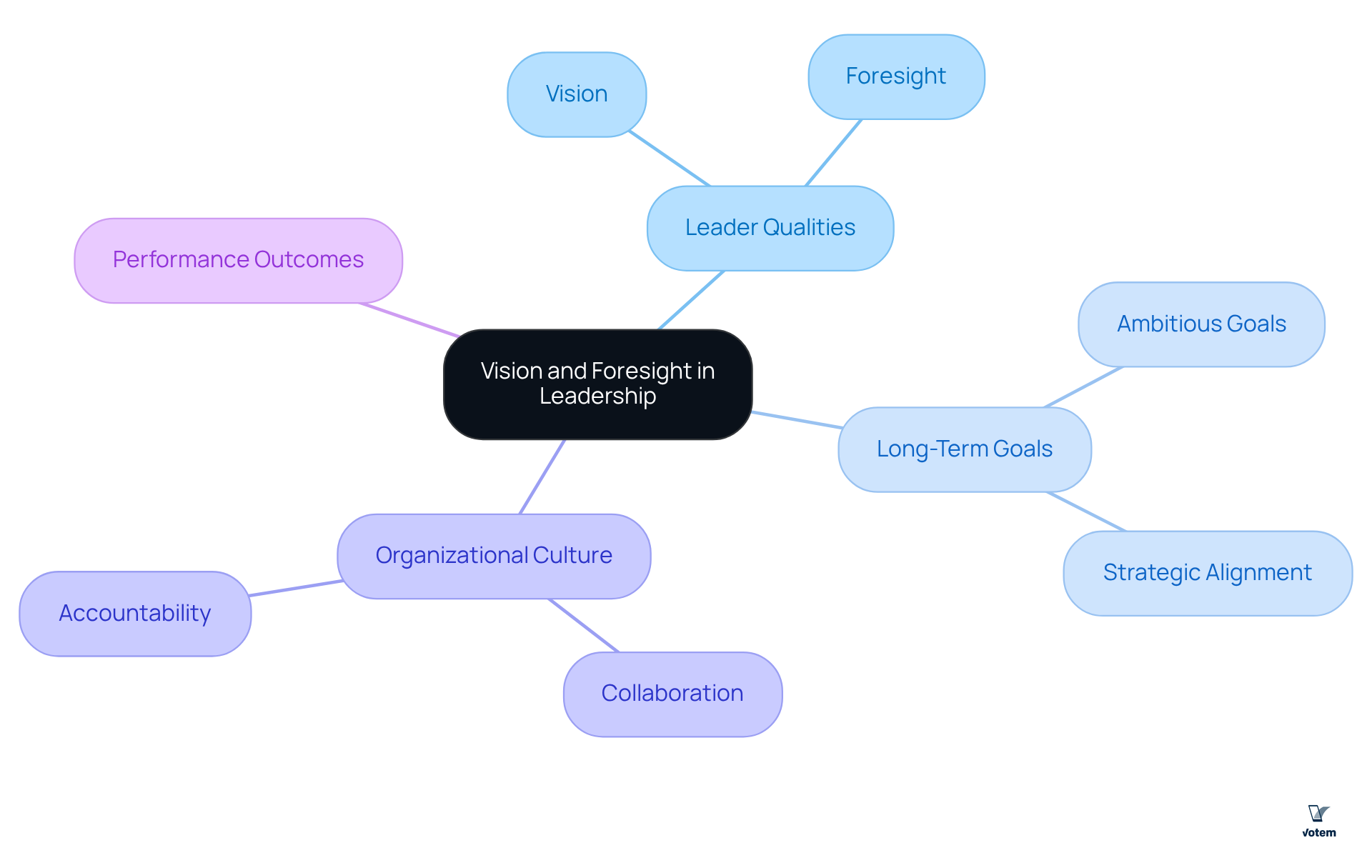
Conclusion
An effective board chairperson embodies essential qualities that not only enhance governance but also drive organizational success. By focusing on:
- Communication
- Collaboration
- Strategic thinking
- Integrity
- Adaptability
- Conflict resolution
- Stakeholder engagement
- Financial acumen
- Vision
a chairperson can significantly influence the board’s effectiveness and the organization’s overall performance.
Throughout this discussion, the importance of these traits has been underscored. Strong communication skills foster productive discussions and ensure that all voices are heard. Collaborative leadership enhances teamwork and leverages diverse perspectives for better decision-making. Furthermore, strategic thinking guides organizations toward their long-term goals, while integrity and ethical standards build trust among stakeholders. Adaptability equips leaders to navigate change, and conflict resolution skills help maintain a harmonious board dynamic. Additionally, financial acumen is crucial for overseeing budgets and making informed economic decisions, while vision and foresight inspire and align the board’s efforts with strategic objectives.
The significance of these qualities cannot be overstated; they are foundational to effective governance and organizational resilience. By prioritizing these traits, board chairpersons can create a culture of accountability, inclusivity, and innovation. As organizations face increasingly complex challenges, the demand for capable leadership becomes paramount. Embracing these key qualities will not only enhance board performance but also contribute to the long-term success and sustainability of the organization.
Frequently Asked Questions
What is Votem’s CastIron platform designed for?
Votem’s CastIron platform is designed to deliver secure and compliant online voting solutions, particularly for entities with stringent governance requirements.
How does Votem ensure compliance in its voting solutions?
Votem adheres to essential regulations such as NCUA, DOL, and ERISA, which helps to bolster voter trust and increase participation in the electoral process.
How many votes has Votem managed, and what does this indicate?
Votem has managed over 13 million votes, showcasing its efficiency and reliability in handling substantial volumes of ballots.
What advantage does the mobile-first design of Votem’s platform provide?
The mobile-first design can amplify voter turnout by up to three times on launch day, providing a significant advantage for organizations.
What feature assists the board chairperson in overseeing elections on Votem’s platform?
The real-time quorum meter is a feature that streamlines the voting process and assists the board chairperson in overseeing elections.
Why are strong communication skills important for a board chairperson?
Strong communication skills are essential for expressing ideas clearly, facilitating productive discussions, and ensuring that all members feel valued and understood.
What impact does effective communication have on employee retention?
Efficient communication is crucial for retaining members and promoting engagement, as research indicates that a significant percentage of employees plan to leave their positions.
How can organizations enhance governance dynamics?
Organizations that prioritize clear communication strategies report enhanced governance dynamics and reduced conflicts.
What role does a board chairperson play in fostering collaborative leadership?
A board chairperson promotes teamwork among committee members by creating an inclusive environment where every voice is acknowledged and appreciated.
What are the benefits of having a diverse board?
Entities with a significant number of female members—specifically, those with 30% or more—experience enhanced internal cultural performance and more informed decision-making.
What is the importance of teamwork among board members?
Teamwork among directors leads to improved organizational performance and a stronger commitment to shared goals.
What are the potential drawbacks of token representation in leadership groups?
Having only one woman or minority member can result in discomfort and diminished participation in discussions.
List of Sources
- Votem: Secure and Compliant Online Voting Solutions
- Attorney General Ken Paxton Launches Investigation Into Reports that Organizations May Be Illegally Registering Noncitizens to Vote (https://texasattorneygeneral.gov/news/releases/attorney-general-ken-paxton-launches-investigation-reports-organizations-may-be-illegally)
- Strong Communication Skills: Essential for Leading Board Discussions
- Effective Communication Strategies for Leaders in the Modern Workplace (https://inspiring-workplaces.com/content/effective-communication-strategies-for-leaders-in-the-modern-workplace)
- Board Communication: Best Practices and Challenges for Success (https://board-room.org/blog/board-communication)
- Effective board communication: Strategies for security, transparency and collaboration (https://diligent.com/resources/blog/effective-board-communication)
- Most important boardroom skills 2025 – The Corporate Governance Institute (https://thecorporategovernanceinstitute.com/insights/thought-leadership/most-important-boardroom-skills-2025?srsltid=AfmBOor0ky91vbrQwgPwonR6iFisZTWLQoIXz7rkYTxqmnQQBiTRu3RR)
- The Art Of Effective Board Leadership: How To Truly Add Value (https://forbes.com/councils/forbesbusinesscouncil/2025/06/11/the-art-of-effective-board-leadership-how-to-truly-add-value)
- Collaborative Leadership: Fostering Teamwork Among Board Members
- Board Leadership (https://neighborworks.org/Training-Services/Nonprofit-Leadership/Board-Leadership)
- Leadership for a collaborative and inclusive future (https://gov.uk/government/publications/health-and-social-care-review-leadership-for-a-collaborative-and-inclusive-future/leadership-for-a-collaborative-and-inclusive-future)
- Nonprofits benefit from having women on executive board – Binghamton News (https://binghamton.edu/news/story/2451/nonprofits-benefit-from-having-women-on-executive-board)
- The Practice Of Collaborative Leadership | The King’s Fund (https://kingsfund.org.uk/insight-and-analysis/reports/practice-collaborative-leadership)
- Strategic Thinking: Guiding the Organization Towards Its Goals
- Leaders at the Forefront of the System’s Development Honored (https://albanymed.org/news/at-the-forefront)
- Board Leadership in an Era of Upheaval (https://russellreynolds.com/en/insights/articles/board-leadership-in-an-era-of-upheaval)
- Using Generative Governance Principles for Better Boardroom Conversations – BoardSource (https://boardsource.org/generative-governance-boardroom-conversations)
- Nelson-Atkins Announces New Strategic Plan, New Board Leadership (https://nelson-atkins.org/about/news/strategic-plan)
- Integrity and Ethical Standards: Building Trust in Leadership
- itdworld.com (https://itdworld.com/blog/leadership/leadership-quotes)
- The Influence of Ethical Leadership on Turnover Intention and Actual Turnover in U.S. Federal Agencies – Intae Choi, 2025 (https://journals.sagepub.com/doi/10.1177/00910260251314543?int.sj-full-text.similar-articles.1)
- How Ethical Leadership Shapes Organizational Culture (https://blogs.psico-smart.com/blog-how-ethical-leadership-shapes-organizational-culture-163465)
- The Impact of Ethical Leadership on Trust Levels between Employees – ProQuest (https://search.proquest.com/openview/fd52e404bd0960416fecd0d43a0253f0/1?pq-origsite=gscholar&cbl=18750&diss=y)
- The Impact Of Ethical Leadership On Building Trust And Corporate Reputation – FasterCapital (https://fastercapital.com/topics/the-impact-of-ethical-leadership-on-building-trust-and-corporate-reputation.html/1)
- Adaptability: Navigating Change and Challenges Effectively
- Board Leadership in an Uncertain Global Business Environment (https://internationalbanker.com/banking/board-leadership-in-an-uncertain-global-business-environment)
- Boards are changing; you need to change with them – The Corporate Governance Institute (https://thecorporategovernanceinstitute.com/insights/thought-leadership/boards-are-changing-you-need-to-change-with-them?srsltid=AfmBOoox3-qpUD–hJ8mS9-uRbirpnmqUn3ux5nRT8r-xacU_k-idniT)
- Board Leadership in an Era of Upheaval (https://corpgov.law.harvard.edu/2025/05/21/board-leadership-in-an-era-of-upheaval)
- The Role of Board Leadership in an Era of Uncertainty – WSJ (https://deloitte.wsj.com/riskandcompliance/the-role-of-board-leadership-in-an-era-of-uncertainty-a65839a4?mod=Deloitte_riskcompliance_wsjsf_title&gaa_at=eafs&gaa_n=ASWzDAgCrJcj6fzf0dYIxzCEFabKT5SgmdBXDMSgVMBPkRsSTNYh4oY4ijrL&gaa_ts=68881507&gaa_sig=oP9dG3uKIFLxSbgFGRCCzk_eNGi63fqdvDChBSN0sRXjRr7N2EW32Mnu6ojAUdAQXU9sgPKTyhp9sA0pgvUYoA%3D%3D)
- Conflict Resolution Skills: Managing Disagreements Effectively
- Handling Nonprofit Board Conflict – BoardSource (https://boardsource.org/handling-board-conflict)
- 4 Steps to Proactively Manage Conflict on Your Board – Charitable Allies (https://charitableallies.org/4-steps-to-proactively-manage-conflict-on-your-board)
- How should a board deal with conflict and division between directors? | CGI (https://thecorporategovernanceinstitute.com/insights/guides/how-to-deal-with-conflict-in-the-boardroom)
- How to run a board meeting: A step-by-step guide (https://fsresidential.com/ontario/news-events/articles/five-steps-for-more-effective-condo-board-meetings)
- Condo board meeting tips: 5 things to consider (https://fsresidential.com/alberta/news-events/articles/5-ways-to-stop-disagreements-from-taking-over-your)
- Stakeholder Engagement: Ensuring All Voices Are Heard
- NQF Board Welcomes 4 New Senior Execs From Leading Healthcare Consumer and Purchaser Organizations | NQF (https://qualityforum.org/en-us/news/nqf_board_welcomes_4_new_senior_execs_from_leading_healthcare_consumer_and_purchaser_organizations)
- Community gathers for Strategic Planning Workshop – District 45 (https://d45.org/news/community-gathers-for-strategic-planning-workshop)
- Eden Prairie School Board candidates address student concerns in final forum – Eden Prairie Local News (https://eplocalnews.org/2024/11/04/eden-prairie-school-board-candidates-address-student-concerns-in-final-forum)
- SPP’s independent and inclusive Markets+ governance model allows diverse voices to drive western market development (https://spp.org/news-list/spp-s-independent-and-inclusive-marketsplus-governance-model-allows-diverse-voices-to-drive-western-market-development)
- Developing A More Inclusive Approach to Climate Change: VCWA Highlights Diverse Voices in Climate Change Discussion — Vermont Council on World Affairs (https://vcwa.org/news/developing-a-more-inclusive-approach-to-climate-change-vcwa-highlights-diverse-voices-in-climate-change-discussion)
- Financial Acumen: Overseeing Budgets and Financial Decisions
- MPHA Welcomes Kevin Reich as Chair of MPHA’s Board of Commissioners (https://mphaonline.org/news/mpha-welcomes-kevin-reich-as-chair-of-mphas-board-of-commissioners)
- CareDx Appoints Bryan Riggsbee to Its Board of Directors (https://investors.caredx.com/news/news-details/2024/CareDx-Appoints-Bryan-Riggsbee-to-Its-Board-of-Directors/default.aspx)
- Mellon Foundation (https://mellon.org/news/margaret-anadu-joins-mellon-foundations-board-of-trustees)
- Dreier Elected New Board Chair of Masonic Homes Kentucky – Masonic Homes Kentucky (https://masonichomesky.com/news/dreier-elected-new-board-chair-of-masonic-homes-kentucky)
- Corbus Pharmaceuticals Strengthens Board of Directors with Appointment of Winston Kung (https://ir.corbuspharma.com/news-events/press-releases/detail/420/corbus-pharmaceuticals-strengthens-board-of-directors-with-appointment-of-winston-kung)
- Vision and Foresight: Setting Long-Term Goals and Inspiring the Board
- About Us – Inspire Brands (https://inspirebrands.com/about-us)
- Cape Symphony Extends Contract for Renowned Conductor Jung-Ho Pak (https://capesymphony.org/blog-news/press-releases/cape-symphony-extends-contract-jung-ho-pak)
- Disney – Leadership, History, Corporate Social Responsibility (https://thewaltdisneycompany.com/about)
- Chair’s Message to Warrington Residents (https://warringtontownship.org/news_detail_T5_R48.php)
- Strategic foresight and business model innovation: The sequential mediating role of sensemaking and learning (https://sciencedirect.com/science/article/pii/S0040162523007801)

